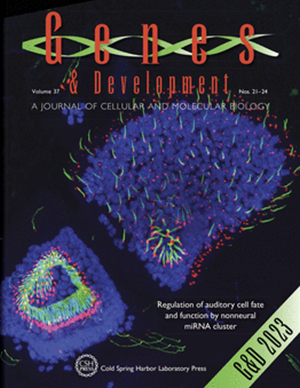The ribosome-associated quality control factor TCF25 imposes K48 specificity on Listerin-mediated ubiquitination of nascent chains by binding and specifically orienting the acceptor ubiquitin
IF 7.7
1区 生物学
Q1 CELL BIOLOGY
引用次数: 0
Abstract
Polypeptides arising from interrupted translation undergo proteasomal degradation by the ribosome-associated quality control (RQC) pathway. The ASC-1 complex splits stalled ribosomes into 40S subunits and nascent chain–tRNA-associated 60S subunits (60S RNCs). 60S RNCs associate with NEMF that promotes recruitment of the RING-type E3 ubiquitin (Ub) ligase Listerin (Ltn1 in yeast), which ubiquitinates nascent chains. RING-type E3s mediate the transfer of Ub directly from the E2∼Ub conjugate, implying that the specificity of Ub linkage is determined by the given E2. Listerin is most efficient when it is paired with promiscuous Ube2D E2s. We previously found that TCF25 (Rqc1 in yeast) can impose K48 specificity on Listerin paired with Ube2D E2s. To determine the mechanism of TCF25's action, we combined functional biochemical studies and AlphaFold3 modeling and now report that TCF25 specifically interacts with the RING domain of Listerin and the acceptor ubiquitin (UbA) and imposes K48 specificity by orienting UbA such that its K48 is directly positioned to attack the thioester bond of the Ube2D1∼Ub conjugate. We also found that TCF25 itself undergoes K48-specific ubiquitination by Listerin, suggesting a mechanism for the reported upregulation of Rqc1 in the absence of Ltn1 and the observed degradation of TCF25 by the proteasome in vivo.核糖体相关质量控制因子TCF25通过结合和特异性定向受体泛素,对新生链的listerin介导的泛素化施加K48特异性
由翻译中断产生的多肽通过核糖体相关质量控制(RQC)途径进行蛋白酶体降解。ASC-1复合体将停滞的核糖体分裂为40S亚基和新生的链trna相关60S亚基(60S RNCs)。60S rna与NEMF相关,促进环状E3泛素(Ub)连接酶Listerin(酵母中的Ltn1)的募集,使新生链泛素化。ring型E3s直接介导Ub从E2 ~ Ub缀合物的转移,这意味着Ub连锁的特异性是由给定的E2决定的。当与混杂的Ube2D E2s配对时,聆听素是最有效的。我们之前发现TCF25(酵母中的Rqc1)可以对与Ube2D E2s配对的Listerin施加K48特异性。为了确定TCF25的作用机制,我们将功能生化研究和AlphaFold3模型结合起来,现在报道TCF25特异性地与Listerin和受体泛素(UbA)的RING结构域相互作用,并通过定向UbA施加K48特异性,使其K48直接定位于攻击Ube2D1 ~ Ub缀合物的硫酯键。我们还发现TCF25本身会被Listerin进行k48特异性泛素化,这提示了在Ltn1缺失的情况下Rqc1上调的机制以及在体内观察到的TCF25被蛋白酶体降解的机制。
本文章由计算机程序翻译,如有差异,请以英文原文为准。
求助全文
约1分钟内获得全文
求助全文
来源期刊

Genes & development
生物-发育生物学
CiteScore
17.50
自引率
1.90%
发文量
71
审稿时长
3-6 weeks
期刊介绍:
Genes & Development is a research journal published in association with The Genetics Society. It publishes high-quality research papers in the areas of molecular biology, molecular genetics, and related fields. The journal features various research formats including Research papers, short Research Communications, and Resource/Methodology papers.
Genes & Development has gained recognition and is considered as one of the Top Five Research Journals in the field of Molecular Biology and Genetics. It has an impressive Impact Factor of 12.89. The journal is ranked #2 among Developmental Biology research journals, #5 in Genetics and Heredity, and is among the Top 20 in Cell Biology (according to ISI Journal Citation Reports®, 2021).
 求助内容:
求助内容: 应助结果提醒方式:
应助结果提醒方式:


